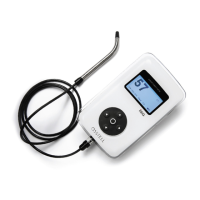ISQ save mode Select ISQ save mode (1, 2 or 3). See also the section “Memory and
saving data”.
Set date Set the date.
Set time Set the time.
Pwr down time Set the time of inactivity before automatic power down.
Beeper vol Set the volume of the audible signals
Disp contrast Set the contrast of the display.
Quit menu Exits the set-up menu.
Language Change language
Host control Control Mode for sending data to a PC or upgrading the instrument
firmware.
Pulse beep Turn on/off the pulsing beep.
Interpreting the result
The ISQ
Stability Measurements using the Osstell
ISQ may be performed at any time after the implant or abut-
ment is placed, assuming there is access to the implant. In most cases, measurements are performed at
implant placement and before the implant is loaded or before the abutment is connected. The stability
is measured at these time points to determine a change in stability. After each measurement, the ISQ
values are recorded and used as the baseline for the next measurement performed. A change in the
ISQ value reflects a change in implant stability.
In general, an increase in ISQ values from one measurement time to the next indicates a progression
towards higher stability and lower ISQ values indicate a loss in stability and perhaps, implant failure.
A stable ISQ value would indicate no change in stability. ISQ values have not been correlated with
other methods of implant mobility measurement.
Implant Stability
An implant has different stability in different directions. The total stability consists of the implant
stability in relation to the surrounding bone, and the stability of the bone itself. There is always a
direction where the stability is the lowest, and a direction where the stability is the highest. These
two directions are perpendicular to each other.
The SmartPeg measures the stability in those two directions, and therefore two different ISQ-values
can be achieved on the same implant. Sometimes, the two ISQ values will be very close to each other,
or even the same. The high value, which in most cases is found in the mesio-distal direction, mainly
reflects the stability in relation to the bone. If a lower value is found, it reflects more of the total
stability, where the bone anatomy is a factor.
Measurements Performed on an Abutment
When a measurement is made on an abutment or on an implant with a “built-in” abutment, the ISQ-
value will be lower compared to a measurement made on the implant. This is due to the difference in
height above bone. To find out the ISQ difference to the measurement performed at implant level, a
measurement should be taken on the implant before the abutment is attached and a second measure-
ment is made.

